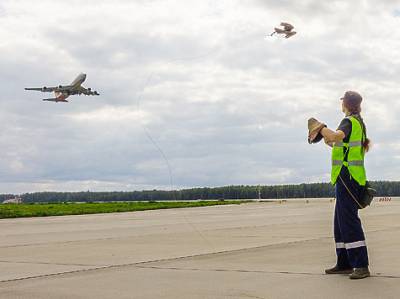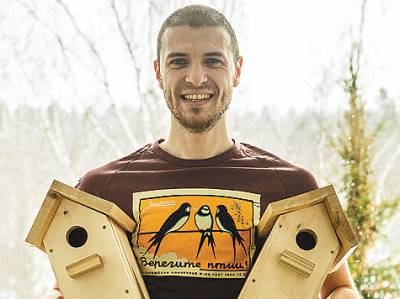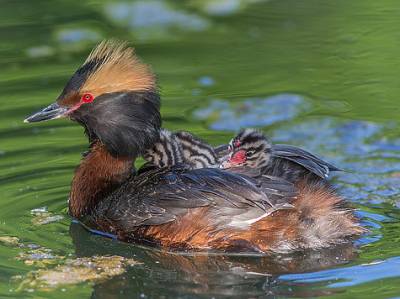
Long time I searched for the toadstool to try to remove, but other than crested grebes anything I have seen. Of course, I am against crested grebes have nothing, especially in the period of bird nesting and weddings. But these birds are very cautious and don’t trust the man. To remove them – you need to thoroughly approach this issue, therefore, is a topic for another post. Other species of grebes, smaller – is another matter. They are more trusting, although stola same small. In particular, Slavonian grebe (Podiceps auritus), which I happened to meet a very difficult but interesting period of the year – a very trustful towards the man.
I met grebe (the grebe) only once at the end of April on Astrahanskie during flight. Then a flock of several birds flitted from me to fifty meters. They seemed small, like the size of Goldeneye or tufted duck, birds. It was black-necked grebes, which are in fact even smaller than krasnochelie.

But when you close the meeting, I was surprised to find that krasnochelie grebes – even smaller little birds, no bigger than a Teal.

I think the superfluous will mention that the grebes to ducks are irrelevant. As they’re not close to any other order of birds. And wearing his Russian name because of the very questionable taste of the meat. Almost their entire diet is fish and aquatic invertebrates, and this directly affects the taste of the fungus. Therefore, they are not useful to the hunter and get shot more often to inexperienced shooters. Nevertheless, these birds often can not be found, their number is very limited.
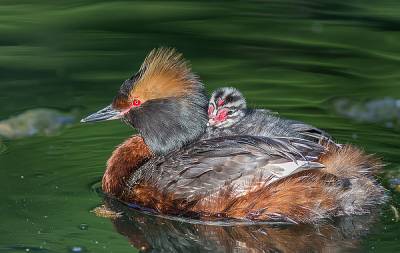

They are territorial and intolerant of members of their own species and to other grebes, especially in the nesting period. But they are excellent parents.

Their entire body is subject to the art of diving, although they fly well enough (grebes inhabiting Russia – migratory, except for those who live in the South where the water never freezes). Streamlined body and legs, lag far back, grebes fast and maneuverable swimming. Grebes are able to adjust the buoyancy of your body, or pressing “ratopariva” water-repellent feathers.

They are able to stay under water for a long time, usually up to a minute or a little less, poniewa if necessary to a hundred meters (often up to 30 meters), deep enough ducking and then catching a fast fish, often large ones for toadstools sizes. I personally watched as a miniature male Slavonian grebes were catching perch and Rotanov length of about 10 cm and tried to feed them to their Chicks, which old was on the strength of a couple of days. However, the latter fulfilled only through time, but still coped.

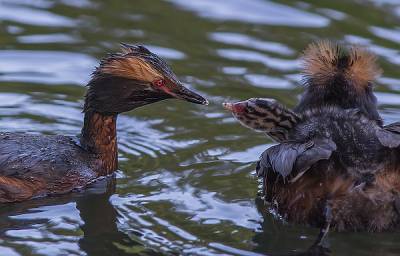
Diving for fish, grebes are often entangled in fishing nets and die.
But on the ground the toadstool almost clumsy and it does not come out.
Grebes , especially krasnochelie, for nesting choose tranquil water features, ponds, oxbow lakes.
The floating nest, composed of twigs and leaves, the female usually hatch about 5 eggs. Sometimes they make it close to terns and gulls, and thus their neighbours advance warning of the danger. However, such nests are very vulnerable to the human factor, namely to the waves created by motor boats. Very often because of this eggs are in the water and the masonry is coming to an end.
Parents sometimes both pokadot the nest to go hunting, and come back to it more often under the water with a long dive, so as not to attract the attention of a possible enemy. It happened with my family that I want to show You. The female laid 5 eggs and jealously guarded them, while the male constantly went for the kill and always come back with a fish and fed it to his wife. Unfortunately, by the time this photo shoot, the Chicks were only three.


No wonder, hooded crows patrolled tirelessly, and don’t miss the chance to catch the chick. And toadstools they are too small and not able to dive. But these birds have adapted differently. They are not hiding in the reeds, as many other waterfowl. As inhabitants of open water bodies and spaces, the Chicks of grebes spend a lot of time on the back of the mother.

There is obviously warm and safe. In newborn Chicks on the head is the area of the skin without feathers, a kind of excrescence, which rushes blood and it turns red. It is believed that in this way the chick signals starvation or overheating.

And dad, as usual, running around the pond in search of fry, continually dives and brings prey to kids. Often to feed the Chicks do fry 2-3 cm long


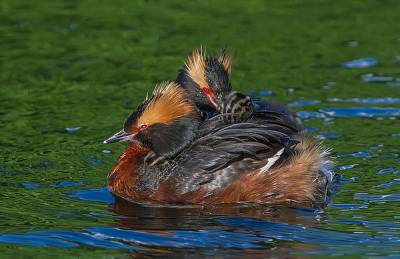
Mother, in contrast, always wet, father, swims a dry, fluffy and turgid, in such moments, does not claim for food and seems completely indifferent.

Although it is nearby to hear the noise, whether the duck will fly or drugoie waterfowl’ll make a fuss, the female guards. And if at that moment the Chicks swim around, then after an inaudible command, they will immediately be saving on the back of the mother.
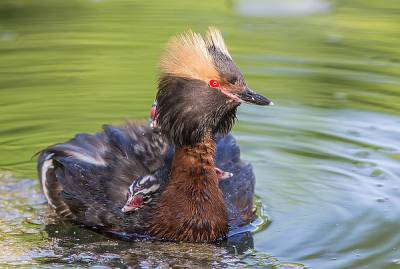
However, two of the Chicks of our heroine, obviously, no luck.
You need to pay attention to the appearance of fungus. These birds are extraordinarily beautiful, especially in the mating season. Lush tuft and whiskers have both sexes, that is, the fungus dimorphism for this trait is almost absent.
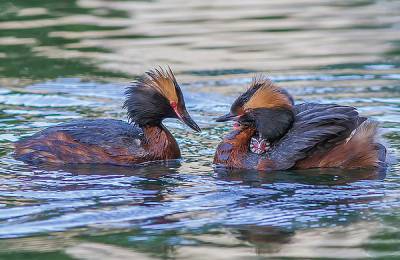
Equally impressive their marriage and courtship and dance. Crested grebes, for example, are able to literally walk on water, and males and females use this dance move synchronously, causing the sight is unique. All dream to make this dance will take place.

